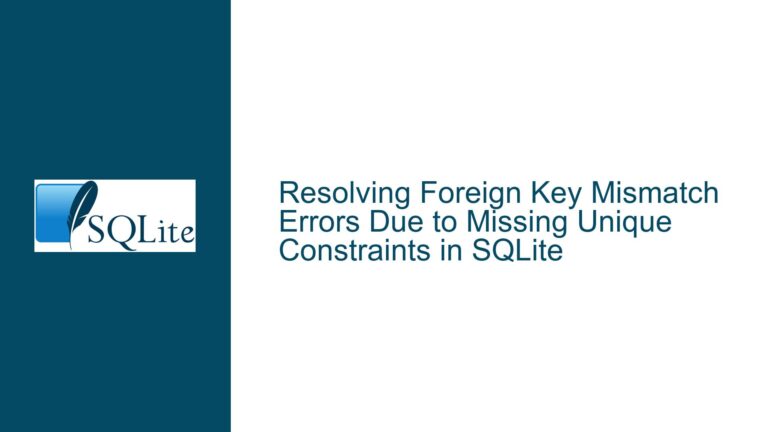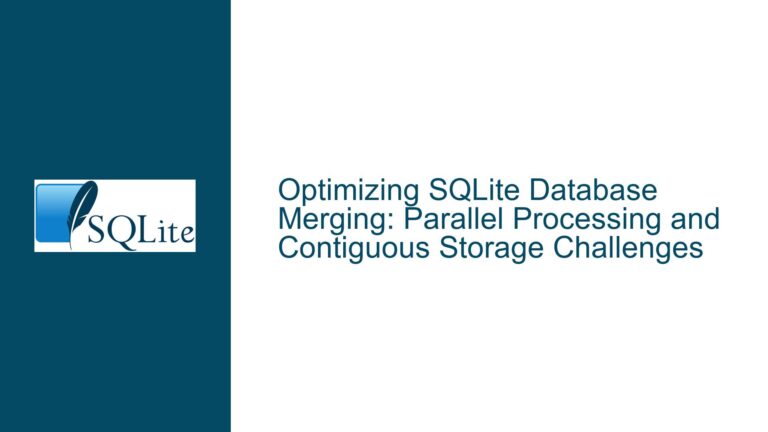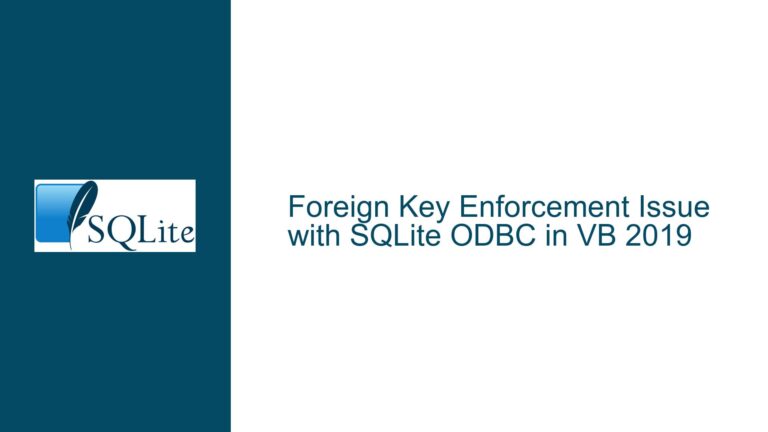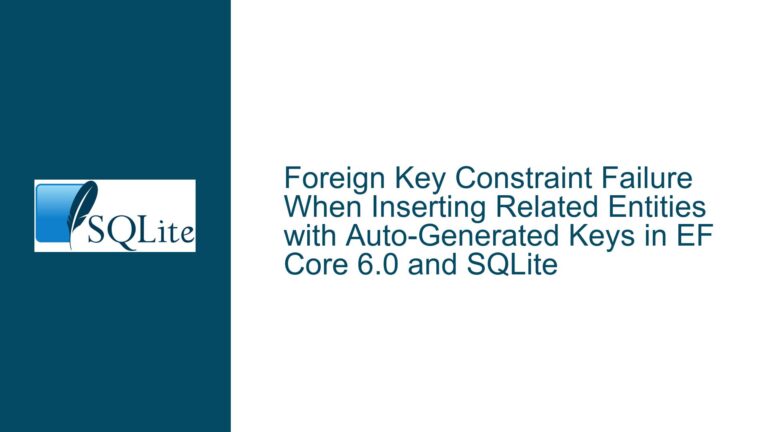MacOS Sonoma SQLite Database Attachment and Table Creation Issue
Issue Overview: MacOS Sonoma Fails to Recognize Attached Database and Table
The core issue revolves around a specific user on MacOS Sonoma encountering an error when attempting to access a table within an attached SQLite database. The error message no such table: secrets.secrets indicates that while the database attachment process appears to succeed, the table within the attached database is not being recognized. This issue is isolated to a single user on MacOS Sonoma, with no reproduction on other systems or environments.
The setup involves a Rust application using the Diesel ORM and the libsqlite3-sys crate to interact with SQLite. The application opens a primary database in rollback journal mode and attaches a secondary database (secrets.db) as secrets upon acquiring a connection from the pool. The application then attempts to query the secrets.secrets table, which fails for the affected user.
The user reports that the issue occurs on a clean run of the software, suggesting that the problem might be related to the initial setup or migration process. The logs indicate that the migration creating the secrets.secrets table was executed successfully, yet the table is not found when queried. This discrepancy points to a potential issue with either the database attachment process, the migration execution, or the filesystem behavior on MacOS Sonoma.
Possible Causes: Filesystem Behavior, Migration Execution, and Database Attachment
Several potential causes could explain why the secrets.secrets table is not being recognized on MacOS Sonoma:
Filesystem Behavior on MacOS Sonoma: MacOS Sonoma might introduce changes in how filesystem operations are handled, particularly concerning file permissions, locking mechanisms, or path resolution. The user’s environment, including potential security settings or filesystem quirks, could interfere with SQLite’s ability to access or recognize the attached database file. For instance, MacOS’s App Sandbox or other security features might restrict access to certain files or directories, even if the paths are correctly specified.
Migration Execution Timing and Consistency: The migration that creates the secrets.secrets table might not be executing as expected on the affected system. While the logs indicate that the migration ran successfully, there could be a timing issue where the migration completes but the changes are not immediately visible to subsequent connections. This could be due to filesystem caching, journaling behavior, or connection pool management. Additionally, if the migration is conditional (e.g., only running if the database file does not exist), it might not execute correctly if the file exists but is corrupted or empty.
Database Attachment Process: The process of attaching the secrets.db database might be failing silently or not persisting across connections. The ATTACH DATABASE command might succeed, but the attached database could be detached or not properly recognized by subsequent queries. This could be due to issues with the connection pool, where different connections do not share the same attached databases, or due to SQLite’s handling of attached databases in a multi-threaded environment.
Path Resolution and Encoding: Although the user reports using only ASCII characters in the file paths, there could still be subtle issues with path resolution or encoding on MacOS Sonoma. SQLite’s handling of file paths, particularly when dealing with non-ASCII characters or special characters, might differ on MacOS Sonoma compared to other systems. This could lead to the database file not being correctly located or accessed.
Troubleshooting Steps, Solutions & Fixes: Diagnosing and Resolving the Issue
To diagnose and resolve the issue, follow these detailed steps:
Step 1: Enable SQLite Logging for Detailed Diagnostics
Enable SQLite’s internal logging using the sqlite3_config function with the SQLITE_CONFIG_LOG option. This will provide detailed logs of SQLite’s operations, including database attachment, query execution, and error messages. The logs can help identify whether the ATTACH DATABASE command is succeeding, whether the secrets.secrets table is being created, and whether any errors are occurring during the process.
Step 2: Verify Database File Paths and Accessibility
Use the sqlite3_db_filename function to log the actual file paths used by SQLite for both the primary and attached databases. This will confirm whether the correct files are being accessed and whether the paths are being resolved as expected. Additionally, check the file permissions and accessibility of the secrets.db file on MacOS Sonoma to ensure that SQLite has the necessary permissions to read and write to the file.
Step 3: Use URI Filenames for Database Attachment
Modify the ATTACH DATABASE command to use URI filenames with the rw mode. This ensures that the attach operation fails if the database file does not exist, providing an explicit error message if the file is not found. For example, instead of attaching the database with a simple file path, use a URI like file:secrets.db?mode=rw. This approach can help identify issues with file existence or accessibility.
Step 4: Ensure Consistent Migration Execution
Review the migration logic to ensure that the CREATE TABLE statement for the secrets.secrets table is always executed, regardless of whether the database file exists. Modify the migration to include the IF NOT EXISTS clause in the CREATE TABLE statement to prevent errors if the table already exists. This ensures that the table is created if it does not exist, even if the database file is present but empty or corrupted.
Step 5: Verify Connection Pool Behavior
Investigate the behavior of the connection pool to ensure that attached databases are shared across connections. If the connection pool creates new connections without re-attaching the secrets.db database, subsequent queries will not have access to the secrets.secrets table. Modify the connection pool configuration to ensure that the ATTACH DATABASE command is executed on every connection acquisition, or implement a mechanism to share attached databases across connections.
Step 6: Test with Different Filesystem Settings
Test the application with different filesystem settings on MacOS Sonoma to identify any filesystem-related issues. For example, disable any security features that might restrict file access, or test with different filesystem formats (e.g., APFS vs. HFS+). Additionally, test the application with different file paths, including paths with non-ASCII characters, to rule out any path resolution or encoding issues.
Step 7: Update SQLite and Dependencies
Ensure that the application is using the latest version of SQLite and related dependencies. Newer versions of SQLite might include bug fixes or improvements that address issues specific to MacOS Sonoma. Additionally, update the libsqlite3-sys crate and Diesel ORM to their latest versions to benefit from any fixes or enhancements related to database attachment and migration execution.
Step 8: Implement Robust Error Handling and Logging
Enhance the application’s error handling and logging to capture more detailed information about database operations. Log the results of the ATTACH DATABASE command, the execution of migrations, and any errors encountered during query execution. This additional logging can help identify the root cause of the issue and provide more context for debugging.
Step 9: Test on a Clean Environment
Set up a clean environment on MacOS Sonoma to test the application from scratch. This includes creating a new user account, installing the application, and running the migrations and queries. This can help identify whether the issue is related to the user’s specific environment or a more general problem with MacOS Sonoma.
Step 10: Consult SQLite Documentation and Community
Review the SQLite documentation for any known issues or limitations related to database attachment, migration execution, and filesystem behavior on MacOS. Additionally, consult the SQLite community and forums for any similar issues reported by other users. The community might provide insights or workarounds that are not immediately apparent from the documentation.
By following these troubleshooting steps, you can systematically diagnose and resolve the issue with the attached database and table recognition on MacOS Sonoma. The combination of detailed logging, path verification, consistent migration execution, and thorough testing will help identify the root cause and implement an effective solution.






